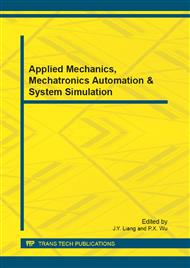[1]
S. Y. Yun, S. O. Bae, J. S. Lim, Zone-based Power Control Scheme for Multi-cell Interference Environments, IEEE Veh. Techno. Conf., 2001, pp: 2903-2907.
DOI: 10.1109/vetecs.2001.944132
Google Scholar
[2]
Y. Wang, Y. M and C. A, On multi-cell interference and capacity of the CDMA forward link with tracking beam antennae, in Proc. IEEE ICC, April 2002, pp: 172-176.
DOI: 10.1109/icc.2002.996839
Google Scholar
[3]
X. Yang, G. Feng, and D. S. C. Kheong, Call Admission Control for Multiservice Wireless Networks With Bandwidth Asymmetry Between Uplink and Downlink, IEEE Trans. on Veh. Techno., Vol. 55, No. 1, January 2006, pp: 360-368.
DOI: 10.1109/tvt.2005.861202
Google Scholar
[4]
X. Pei, T. Jiang, D. Qu, G. Zhu and J. Liu, Radio-Resource Management and Access-Control Mechanism Based on a Novel Economic Model in Heterogeneous Wireless Networks, IEEE Trans. Veh. Techno., Vol. 59. No. 6, July 2010, pp: 3047-3056.
DOI: 10.1109/tvt.2010.2049039
Google Scholar
[5]
V. G. Subramanian, R. A. Berry, and R. Agrawal, Joint Scheduling and Resource Allocation in CDMA Systems, IEEE Trans. Information theory, Vol. 56. No. 5, May 2010, pp: 2416-2432.
DOI: 10.1109/tit.2010.2040860
Google Scholar
[6]
H. Jiang, W. Zhuang, X. Shen, and Q. Bi, Quality-of-Service Provisioning and Efficient Resource Utilization in CDMA Cellular Communications, IEEE J. Sel Areas Commun, Vol. 24, No. 1, January 2006, pp: 4-15.
DOI: 10.1109/jsac.2005.858897
Google Scholar
[7]
Y. W. Kim, D. K. Kim, J. H. Kim, S. M. Shin and D. K. Sung, Radio Resource Management in Multiple-Chip-Rate DS/CDMA Systems Supporting Multiclass Services, IEEE Trans. Veh. Techno., Vol. 50. No. 3, May 2001, pp: 723-736.
DOI: 10.1109/25.933308
Google Scholar
[8]
S. K. Das, S. K. Sen, K. Basu and H. Lin, A Framework for Bandwidth Degradation and Call Admission Control Schemes for Multiclass Traffic in Next-Generation Wireless Networks, IEEE J. Sel Areas Commun. Vol. 21, no. 10, pp: 1790-1802, December (2003).
DOI: 10.1109/jsac.2003.815928
Google Scholar
[9]
K. S. Gilhousen, I. M. Jacobs, R. Padovani, On the capacity of a cellular CDMA system, IEEE Trans. on Veh. Techno., Vol. 40, No. 1, May 1991, pp: 303-312.
DOI: 10.1109/25.289411
Google Scholar
[10]
S-Jun Oh, and A. C. K. Soong, QoS-Constrained Information-Theoretic Sum Capacity of Reverse Link CDMA Systems, IEEE Trans. Wireless. Commun., Vol. 5. No. 1, January 2006, pp: 3-7.
DOI: 10.1109/twc.2006.1576517
Google Scholar


